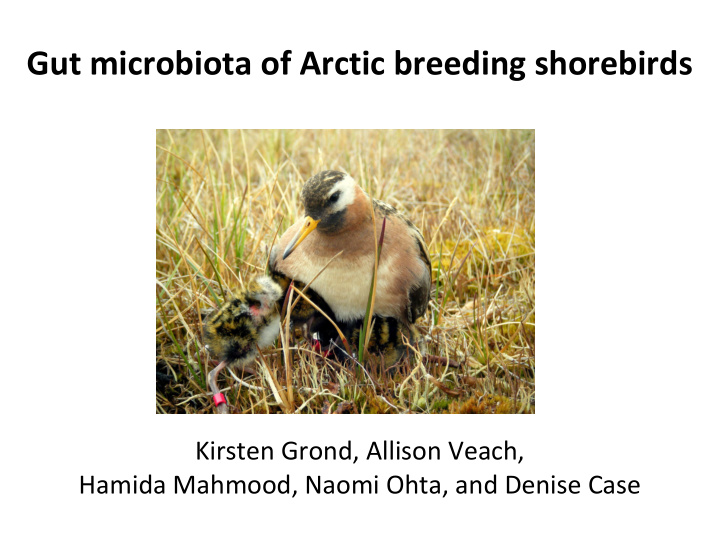



Gut microbiota of Arctic breeding shorebirds Kirsten Grond, Allison Veach, Hamida Mahmood, Naomi Ohta, and Denise Case
Outline • Background • Research Question • Experimental Design • Methods & Analyses pipeline • Local Alignment • Multiple Sequence Alignment • Classification & OTU Clustering • OTU Classify • Data visualization & Results • Future Work
Background
Why gut microbiota? Gut microbiota important in health (Kohl 2012) •Nutritional uptake •Detoxification •Interactions with immune system Humans: Unbalanced gut microbiota → Obesity, Diabetes, Gut inflammation (IBS), Depression • (Bonfrate et al. 2013; Dinan & Cryan 2013; Fang & Evans 2013; Le Chatelier et al. 2013)
Why shorebirds? • Sensitive to change • “Living on the edge” • Many Arctic breeding species declining fast Dunlin Calidris alpina
Research Question Do intrinsic or extrinsic factors determine gut microbiome composition in shorebirds? Intrinsic → Host species phylogeny Extrinsic → Environment (breeding site, migration route, interaction with conspecifics etc.)
Research Questions Do intrinsic or extrinsic factors determine gut microbiome composition in shorebirds? Intrinsic → Host species phylogeny Extrinsic → Environment (breeding site, migration route, interaction with conspecifics etc.)
Experimental Design & Software
Sample collection 538 fecal samples of 10 shorebird species from 9 Arctic breeding sites Selected a subset of 138 samples, all from Dunlin to speed up analysis - Making contigs for 538 samples took >200 hrs Used the Illumina MiSeq platform to sequence the V4 region of the 16S ribosomal RNA
16S rDNA (double lines indicate variable or hypervariable; gray lines indicate highly conserved; V1 to V9 indicate major variable regions). V4 Tortoli E Clin. Microbiol. Rev. 2003;16:319-354
Illumina MiSeq
Illumina MiSeq Short fragments (V4) 291 bp
Illumina MiSeq Short fragments (V4) ~250 bp Attach adapters for sequencing
Illumina MiSeq Short fragments (V4) ~250 bp Attach adapters for sequencing Apply to flow cell with attached primer
Illumina MiSeq Short fragments (V4) ~250 bp Attach adapters for sequencing Apply to flow cell with primers Amplify and create clusters
Illumina MiSeq Short fragments (V4) ~250 bp Attach adapters for sequencing Apply to flow cell with primers Amplify and create clusters
www.mothur.org
Mothur in Beocat Created shell files with Mothur commands in batch
Pipeline Local alignment make.contigs, summary.seqs, screen.seqs, trim.seqs Multiple alignment unique.seqs, summary.seqs, align.seqs Classification & OTU clustering pre.cluster, chimera.uchime, classify.seqs, remove.lineage, cluster OTU Classify remove.rare, classify.otus, remove.lineage
Methods: Local Alignment & Cleanup
Local Alignment - Making contigs - make.contigs(file=/homes/kgrond/Shorebird_seqs/mothur/allfecal ) - Combine forward and reverse fastq files and make contigs to reduce PCR errors. Forward fastq Sample ID Reverse fastq
Local Alignment - Make contigs. algorithm - make.contigs(file=/homes/kgrond/Shorebird_seqs/mothur/allfecal ) - Uses the Needleman algorithm for local alignment of paired end - sequences In case of … Gap: the quality score of the base must be over 25 to be considered real. Mismatch: require one of the bases to have a quality score 6 or more points better than the other, otherwise sequence will shown as “N”.
Local Alignment - summary seqs - Summary.seqs(fasta=/ homes/kgrond/Shorebird_seqs/mothur/allfecal ) Most reads vary between 228 and 373 bases.
Cleanup the sequences - Screen.seqs - Screen.seqs(fasta=/homes/kgrond/Shorebird_seqs/mothur/allfecal.trim.contigs. fasta,group=/homes/kgrond/Shorebird_seqs/mothur/allfecal.contigs.groups, minlength=250, maxlength=350, maxambig=0) - Length range between 250 – 350 - Sequences with ambiguous based are not retained Summary.seqs After each step, we run “Summary.seqs” to check if the previous command has worked.
Cleanup the sequences - Trim.seqs - Trim.seqs(fasta=/homes/kgrond/Shorebird_seqs/mothur/allfecal, maxhomop=8, flip=T) - Any sequences with homopolymers (-ATCCCCCCCCC) are removed. - Take the reverse complement of PCR primer. “flip=T(rue)
Multiple Alignment, Clean up, Sequence Classification
Multiple Alignment, Sequence Cleanup and Classification Unique.seqs(fasta=/homes/kgrond/Shorebird_seqs/mothur/allfecal. trim.contigs.good.fasta) - Analysis uses only representative sequences to reduce computing time Summary.seqs (fasta=/homes/kgrond/Shorebird_seqs/mothur/allfecal.trim.contigs. good.trim.unique.fasta, name=homes/kgrond/Shorebird_seqs/mothur/allfecal.trim.contigs. good.trim.names)
Multiple Alignment, Sequence Cleanup and Classification Align.seqs(fasta=homes/kgrond/Shorebird_seqs/mothur/allfecal. trim.contigs.good.trim.unique.fasta , reference=/homes/kgrond/Shorebird_seqs/mothur/ silva.bacteria. fasta) - Template DB is SILVA containing aligned 16S rRNA sequences
Multiple Alignment, Sequence Cleanup and Classification Pre.cluster(fasta=/homes/kgrond/Shorebird_seqs/mothur/allfecal. trim.contigs.good.trim.unique.good.align, name=/homes/kgrond/Shorebird_seqs/mothur/allfecal.trim.contigs. good.trim.good.names, group=/homes/kgrond/Shorebird_seqs/mothur/allfecal.contigs.good. good.groups, diffs=2) Sequences abund ranked then sequences within ≤ 2 mismatches are merged - - Reduces computing time and accounts for sequenced generated artifacts
Multiple Alignment, Sequence Cleanup and Classification chimera.uchime (fasta=/homes/kgrond/Shorebird_seqs/mothur/allfecal.trim.contigs. good.trim.unique.good.precluster.align, name=/homes/kgrond/Shorebird_seqs/mothur/allfecal.trim.contigs. good.trim.unique.good.precluster.names) - Remove chimeric sequences Picture credit: http://drive5. com/usearch/manual/chimera_formation.html
Multiple Alignment, Sequence Cleanup and Classification remove.seqs (accnos=/homes/kgrond/Shorebird_seqs/mothur/allfecal.trim. contigs.good.trim.unique.good.precluster.uchime.accnos, fasta=/homes/kgrond/Shorebird_seqs/mothur/allfecal.trim.contigs. good.trim.unique.good.precluster.align, name=/homes/kgrond/Shorebird_seqs/mothur/allfecal.trim.contigs. good.trim.unique.good.precluster.names, dups=T) Picture credit: http://drive5. com/usearch/manual/chimera_formation.html
Multiple Alignment, Sequence Cleanup and Classification classify.seqs(fasta=/homes/kgrond/Shorebird_seqs/mothur/allfecal. trim.contigs.good.trim.unique.good.precluster.pick.align, name=/homes/kgrond/Shorebird_seqs/mothur/allfecal.trim.contigs. good.trim.unique.good.precluster.pick.names, template=/homes/kgrond/Shorebird_seqs/mothur/trainset9_032012 .rdp.fasta, taxonomy=/homes/kgrond/Shorebird_seqs/mothur/trainset9_03201 2.rdp.tax, cutoff=80) - Template database used is the RDP training set 9 - Taxonomy is also derived from RDP DB - Cutoff retains only taxonomic affiliations with bootstrap support at 80%
Multiple Alignment, Sequence Cleanup and Classification remove.lineage(fasta=/homes/kgrond/Shorebird_seqs/mothur/allfecal.trim. contigs.good.trim.unique.good.precluster.pick.align, name=/homes/kgrond/Shorebird_seqs/mothur/allfecal.trim.contigs.good.trim. unique.good.precluster.pick.names, taxonomy=/homes/kgrond/Shorebird_seqs/mothur/allfecal.trim.contigs.good.trim. unique.good.precluster.pick.rdp.wang.taxonomy, taxon=unknown-Bacteria; unclassified-Bacteria;Cyanobacteria_Chloroplast;unclassified-Bacteria; Cyanobacteria_Chloroplast;Chloroplast-Archaea-Mitochondria-Eukaryota) - Template database used is the RDP training set 9 - Taxonomy is also derived from RDP DB - Cutoff retains only taxonomic affiliations with bootstrap support at 80%
Multiple Alignment, Sequence Cleanup and Classification Sequence name AY457915 Bacteria(100);Firmicutes(100);Clostridiales(100);Johnsonella_et_rel. (100);Johnsonella_et_rel.(100);Johnsonella_et_rel.(100); Eubacterium_eligens_et_rel.(100);Lachnospira_pectinoschiza(100);unclassified; unclassified;unclassified;unclassified;unclassified; 100% bootstrap support for Domain Bacteria, Phylum Firmicutes, Order Clostridiales … Genus
OTU Classification
OTU Clustering and Classification Dist.seqs(fasta=final.fasta, cutoff=0.10) Cluster (column=/homes/kgrond/Shorebird_seqs/mothur/name=final.dist, name= /homes/kgrond/Shorebird_seqs/mothur/) - Dist.seqs calculated uncorrected pairwise distances between aligned and classified sequences - Using a nearest neighbor clustering method, distances are used to create OTU’s at 97% similarity threshold
OTU Clustering and Classification Classify.otu(list= /homes/kgrond/Shorebird_seqs/mothur/ final.an. list, name /homes/kgrond/Shorebird_seqs/mothur/ final.names, taxonomy /homes/kgrond/Shorebird_seqs/mothur/ final. taxonomy, label=0.03) - Using taxonomy after removing unwanted sequences and rare OTU’s, the updated RDP reference is used to classify each OTU to lowest taxonomic affiliation with acceptable bootstrap support
Data Visualization
Recommend
More recommend